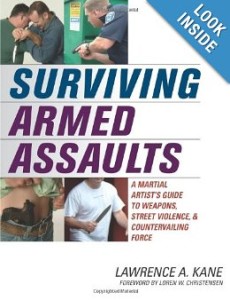 Self-defense and martial arts author Lawrence Kane delivers an excellent book with his Surviving Armed Assaults: A Martial Artists Guide to Weapons, Street Violence, and Countervailing Force.
Self-defense and martial arts author Lawrence Kane delivers an excellent book with his Surviving Armed Assaults: A Martial Artists Guide to Weapons, Street Violence, and Countervailing Force.
I reviewed this book, Surviving Armed Assaults, a number of years ago, and am adding to the review to post here. When I originally read this book and wrote a review, I had not become friends with Kane yet. We are now friends, and I recommend this book and his others, not just because we are friends, but because Kane knows his stuff and writes excellent books on self-defense and various aspects of the martial arts.
Surviving Armed Assaults original review:
I will admit that I started reading this book a bit biased toward it being good. I have read other books by Kane that I enjoyed, I’ve contributed a chapter, as did Kane, to Loren Christensen’s Fighter’s Fact Book 2 and Christensen wrote a Foreword for the book, and to top if off, best selling author Barry Eisler mentioned me in his praise for the book on the inside cover. So yes, I expected it to be a good book and one that I would like.
However, what I did not expect is how good it really is and how much excellent material Kane offers in this one volume. Because of the things mentioned in the first paragraph, one could easily say I am biased, and maybe I am a bit. With that said, I am writing a review and endorsing this book wholeheartedly because it is an exceptional addition to anyone’s self-defense library and a book that has potential to save lives if people read it and listen to Kane’s advice.
The first chapter is on awareness, a topic I also write and speak about, so I was especially interested in what Kane had to say. So what does he do? He starts the chapter off with a quote from Ani DiFranco, “Any tool is a weapon if you hold it right.” This grabbed my attention because I once headed the local security for a concert of hers and had a very good talk about penjak silat with her bodyguard as we waited for her to change so we could walk her to the bus. It means nothing to anyone else, but hooked me. I continued and was fully engrossed with the statistics and examples Kane provided relating to violence. Reading those made me glad that there are those of us out here doing what we can to prevent violence and teach people to avoid or deal with it if necessary. Something Kane’s Surviving Armed Assaults does very well. Kane did an excellent job with his chapter on awareness, and even though he teaches a modified color code a bit differently than I teach, I believe this chapter should be read by everyone in order to wake up and be more aware so they could avoid many potentially dangerous situations.
Situational Awareness is important! If you have not signed up for my newsletter and downloaded my guide to awareness, do so now by submitting your name and e-mail over on the right.
Speaking of avoidance, that was the focus of chapter two. Kane not only makes a great argument of why you should avoid violence, but provides strategies to do so. He follows this with a chapter on scenarios that extends the awareness and avoidance topics to situations such as car jackings, cash machine safety, hostage situations, sexual assault, rape, workplace violence and more. Before dealing with physical responses, Kane focuses on de-escalation strategies in chapter four. This is an often overlooked aspect of self-defense books and a welcome and needed addition here. Many self-defense books focus on striking and kicking and forget that if you can talk your way out of a situation you will be much better off than having fought your way out. Kane gives some excellent advice with his de-escalation strategies and I again wish everyone would learn these. One of the reasons a person is much better off by de-escalating a situation is because of the potential legal ramifications that may follow a physical altercation. As an attorney, I am very familiar with such things, and feel that Kane did a good job with his chapter on countervailing force that included legal considerations.
The remaining chapters focus on armed conflict, rules to live by, the aftermath of violence, and weapon features and functions. Some of the information in these chapters is biased toward Kane’s karate training. Practitioners from other styles may not benefit from these chapters as much as the first ones, but I would encourage everyone to take even the karate parts and look how the principles behind what Kane teaches applies to their own art or self-defense system. (Kane’s nine rules could apply to any art or system)
This is an excellent book filled with practical and realistic information related to weapons and violence. There is researched data and personal anecdotes that support Kane’s perspectives on violence and his illustrations of real violence and what to do about it, or most importantly, how to be aware of it and avoid it altogether. I wholeheartedly recommend this book to martial artists and anyone interested in self-defense.
You can check out Surviving Armed Assaults at amazon:


Be the first to comment on "Surviving Armed Assaults: A Martial Artists Guide to Weapons, Street Violence, and Countervailing Force"